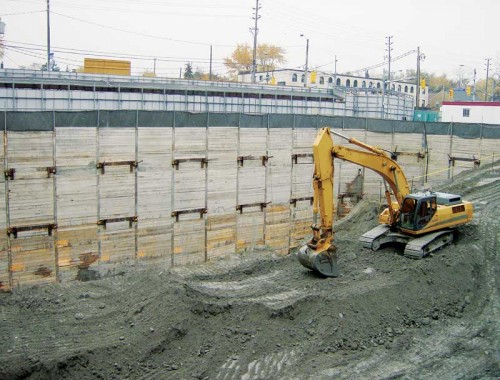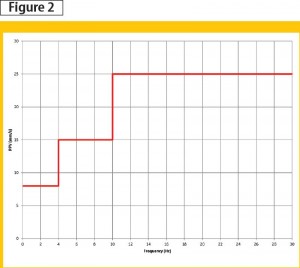Specifying construction vibration requirements

By Ian L. Matthew, MSc., P.Eng., and Al Lightstone, PhD, P.Eng.
Ground-borne vibration can be produced by various common construction activities, including caisson drilling, piledriving, and soil compaction. In extreme cases, such vibration produced at a construction site has the potential to damage buildings or structures outside the limits of the site; at the very least, it creates an annoyance or nuisance in nearby buildings. A clear understanding of the potential hazard is important.
In 2008, Toronto enacted its Vibration Control Bylaw 514-2008, Chapter 363, “Building Construction and Demolition,” of the city’s municipal code. It requires those applying for permits for construction or demolition to assess and, in some cases, monitor the potential vibration impact of the construction activities. The purpose is to avoid the potential for adverse vibration impact. Although this is understood to be unique to Toronto at this time, other municipalities are expressing interest in enacting similar legislation.
Getting technical
Vibration causes the particles in the ground/soil to move back and forth (i.e. oscillate) from their rest position. Two characteristics of the vibration are important (Figure 1):
- how long a particle took to complete one oscillation; and
- the maximum velocity that the particle experienced during its oscillation.
The first item defines the frequency of the oscillation, usually referred to in Hertz (Hz) or cycles per second. The second item is the ‘peak particle velocity (PPV),’ or the maximum velocity (in mm/s) experienced by the particle as it oscillates back and forth in response to the excitation (i.e. construction activity).

The risk of potential damage to a structure is correlated with PPV. For any given value of PPV, the total particle displacement (i.e. distance travelled) is greater if the oscillation frequency is lower. Thus, the vibration criteria (in terms of PPV) are frequency dependent and more stringent at lower frequencies.
Bylaw particulars
The Toronto bylaw provides vibration limits at neighbouring properties, applicable to the use of construction equipment on a construction/demolition site (Figure 2). However, there is also a provision for the professional engineer making submissions under the bylaw to identify more stringent requirements if necessary. The bylaw requires an application for a permit for construction (i.e. building permit) or demolition be accompanied by a vibration control form. This form (Section C of the bylaw) provides a roadmap for the overall application and approval process. The form itself is divided into sections and follows an ‘if–then’ format.
Section A––Section C (2) of bylaw
The applicant must declare whether certain activities will occur as part of the construction/demolition process. Specifically, the list includes:
- blasting;
- deep foundations;
- drilled caissons;
- large-scale soil compaction;
- construction within the water table; and
- any other construction activity or method that has the potential to cause vibrations which may impact buildings or structures outside the construction site.
It is important to note the last bullet item is a ‘catch all,’ leaving the actual scope of the work to the discretion and responsibility of the engineer completing the form.

Section B––Section C (3) of bylaw
If any activity listed in Section C (2) is to be conducted, the proponent must now submit a preliminary study prepared by a professional engineer to evaluate the potential impact of the project on the nearby neighbours. The study must include a plan showing the construction site, along with adjacent land and buildings, that identifies the zone of influence (ZOI) of vibrations. It must also show whether the ZOI extends beyond the legal boundaries of the construction site that is the subject of the permit application. Further, it needs to show any buildings designated under the Ontario Heritage Act located within the zone.
Additionally, a general review commitment certificate and letter of undertaking in a form acceptable to the chief building official must be included. In effect, this form is an undertaking/confirmation the applicant/owner has retained qualified professionals––architects or engineers––to do general reviews of the construction/demolition to ensure conformity with the permit documents. It is also from the professional consultants, demonstrating they are qualified and have been engaged for the above reviews.
The ZOI defined in the bylaw is the area of land within or adjacent to a construction site––including any buildings or structures––that potentially may be impacted by vibrations emanating from a construction activity where the PPV at the point of reception would be equal to or greater than 5 mm/s (0.20 in./s) at any frequency.
As the 5 mm/s criterion for the ZOI is more stringent than the vibration limits, the ZOI is intended to cast a somewhat wide net in determining the existence of nearby structures that could be impacted by the activity on the construction site. A sample ZOI diagram is presented in Figure 3.

The professional engineer completing the ZOI is obligated under Section C (4) to consider unique site conditions and whether it would be prudent to enlarge the zone of influence beyond that determined from the stated vibration limits (i.e. adopt more stringent vibration limits). Such would be typical if a heritage building is within the ZOI, since lower vibration limits are appropriate for heritage buildings (e.g. 3 mm/s [0.12 in./s] for vibration below 4 Hz).
It deserves mention the bylaw and vibration control form refer to buildings “designated” under the Ontario Heritage Act (R.S.O. 1990, Chapter O.18). Although the word designated is not capitalized in the form, the Ontario Heritage Act defines the term as property designated by a municipality under section 29 [of the Act]. The City of Toronto Heritage Properties Inventory includes properties that carry a status of either “listed” or “designated,” and it would lead one to conclude only designated properties must be considered. However, the engineer must be aware the ZOI definition could include ‘such greater area,’ as determined by the professional engineer based on, among other considerations, the potentially sensitive nature of nearby buildings and whether they carry a listed or designated status.







